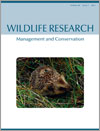Context . For the success of future conservation and management programs, it is necessary to better understand the resilience mechanisms of invasive species and their invasive potential. In this sense, the study of the effects that management actions have on their biological traits is essential.
Aims . The present study aimed to assess the effects of removal control on the abundance and biology of an isolated population of the top invasive fish Gambusia holbrooki (eastern mosquitofish).
Methods . Experimental removal control with traps and handnets was carried out on a population of mosquitofish inhabiting a small semiarid stream in south-eastern Spain. Mosquitofish were periodically captured for more than 3 years. Temporal variations in abundance, fish somatic condition and reproductive investment, percentage of mature females, size at maturity and population recruitment were analysed.
Key results . Individuals of the 1 age class increased their reproductive investment when population abundance was lower, thus increasing recruitment rate during the first months of the recruitment period. Individuals of the 0 age class were responsible for expanding the reproductive period in conditions of low fish abundance.
Conclusions . The mosquitofish population showed variations of reproductive parameters that could indicate a compensatory density-dependent phenotypic response under diminished abundance conditions. However, its removal by the constant use of a combination of active and passive capture methods, reinforced by increased extraction effort according to its local biology, has led to an eradication of the population. The target mosquitofish population showed distinct ecological features that may have contributed to the effectiveness of local control, namely, low initial fish density, isolation in a headwater stretch and the prevalence of individuals in sunlit shallow ponds.
Implications . The compensatory mechanisms of this invasive species in low-density conditions should be considered in the design of management programs. Moreover, further research into removal control methods for mosquitofish or similar species is also needed.





